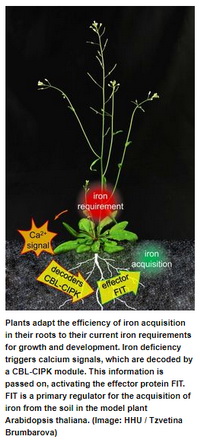
Research Groups Discover How Plants Cope with Iron Deficiency
February 6, 2019| |
 Research groups from Heinrich Heine University Düsseldorf (HHU) and the University of Münster (WWU) have discovered a new switch that plants use to control their responses to iron deficiency.
Research groups from Heinrich Heine University Düsseldorf (HHU) and the University of Münster (WWU) have discovered a new switch that plants use to control their responses to iron deficiency.
Iron regulation is an important model system in plant biology for understanding how cellular regulation processes impact on each other and the related signalling paths. The HHU and WWU research teams have examined the special mechanisms and dynamics of a protein named "FIT" in iron uptake and have discovered cellular information processes that impact on FIT. The protein was discovered by Prof. Petra Bauer's group.
The regulation mechanisms are being examined at the Institute of Botany at HHU. FIT can be present in an active and inactive state. It plays a key role in regulating iron uptake in Arabidopsis thaliana. How the plant decides how much iron to absorb and how to transmit this information to the FIT regulator is, however, the subject of current research at HHU. The WWU research group looked at calcium signal transduction which involves response to iron deficiency. They then analyzed the iron concentration in the plants.
The precise link between iron and calcium was unclear. However, the research groups have found that iron deficiency triggers calcium signals, having a significant influence on the FIT regulation mechanism. They describe how the enzyme CIPK11 linked to calcium detection interacts with and mark the FIT protein. Plants ultimately use this FIT activation to control iron uptake in its roots and iron storage in its seeds.
For details, read the research news from HHU.
| |
Biotech Updates is a weekly newsletter of ISAAA, a not-for-profit organization. It is distributed for free to over 22,000 subscribers worldwide to inform them about the key developments in biosciences, especially in biotechnology. Your support will help us in our mission to feed the world with knowledge. You can help by donating as little as $10.
-
See more articles:
-
News from Around the World
- FAO: Sustainable Agri Requires an Integrated Approach
- USDA ARS Female Biologist Bags NAS Food And Agricultural Science Prize
- SEARCA-BIC Policy Brief Analyzes the Cost of Regulatory Delays for GM Crops
- Scientists Sequence Genome of Broomcorn Millet
- Substance that Gives Rapeseed a Bitter Taste Has Been Discovered
- Near-complete Genome Sequence of Snapdragon Successfully Assembled
- Research Groups Discover How Plants Cope with Iron Deficiency
-
Research Highlights
- Overexpression of Moss Gene in Cotton Enhances Yield and Fiber Quality
- Biofortified Cassava Shows Higher Levels of Iron
-
Beyond Crop Biotech
- GM Chickens Developed to Lay Anti-cancer Eggs
-
From the BICs
- Communicating Scientific Issues Responsibly
-
Announcements
- Genetic Biocontrol for Invasive Species
-
Plant
- CRISPR-Cas9 System Used to Develop First-Ever Plantain Resistant to Banana Streak Virus
- New CRISPR Database to Catalyze Collaborations
- Agrobacterium-delivered CRISPR-Cas9 System for Genome Editing of Wheat
-
Read the latest: - Biotech Updates (December 10, 2025)
- Gene Editing Supplement (December 17, 2025)
- Gene Drive Supplement (February 22, 2023)
-
Subscribe to BU: - Share
- Tweet
